 W
WThe Bachem Ba 349 Natter was a World War II German point-defence rocket-powered interceptor, which was to be used in a very similar way to a manned surface-to-air missile. After a vertical take-off, which eliminated the need for airfields, most of the flight to the Allied bombers was to be controlled by an autopilot. The primary role of the relatively untrained pilot was to aim the aircraft at its target bomber and fire its armament of rockets. The pilot and the fuselage containing the rocket motor would then land using separate parachutes, while the nose section was disposable.
 W
WThe Dornier Do 335 Pfeil ("Arrow") was a heavy fighter built by Dornier for Germany during World War II. The two-seater trainer version was called Ameisenbär ("anteater"). The Pfeil's performance was much better than other twin-engine designs due to its unique push-pull configuration and the lower aerodynamic drag of the in-line alignment of the two engines. It was Nazi Germany's fastest piston-engined aircraft of World War II. The Luftwaffe was desperate to get the design into operational use, but delays in engine deliveries meant that only a handful were delivered before the war ended.
 W
WThe Emergency Fighter Program was the program that resulted from a decision taken on July 3, 1944 by the Luftwaffe regarding the German aircraft manufacturing companies during the last year of the Third Reich.
 W
WThe Focke-Wulf Fw 187 Falke ("Falcon") was a German aircraft developed in the late 1930s. It was conceived by Kurt Tank as a twin-engine, high-performance fighter, but the Luftwaffe saw no role for the design, perceiving it as intermediate between the Messerschmitt Bf 109 and Bf 110. Later prototypes were adapted to two-seats to compete with the Bf 110 in the Zerstörer role, but only nine aircraft were built in total.
 W
WThe Focke-Wulf Fw 190 is a German single-seat, single-engine fighter aircraft designed by Kurt Tank at Focke-Wulf in the late 1930s and widely used during World War II. Along with its well-known counterpart, the Messerschmitt Bf 109, the Fw 190 became the backbone of the Jagdwaffe of the Luftwaffe. The twin-row BMW 801 radial engine that powered most operational versions enabled the Fw 190 to lift larger loads than the Bf 109, allowing its use as a day fighter, fighter-bomber, ground-attack aircraft and to a lesser degree, night fighter.
 W
WThe Focke-Wulf Super Lorin was a proposed German jet interceptor project. Designed towards the end of World War II by engineer Heinz von Halen, the project remained only a factory design exercise, and never received an RLM airframe number before the surrender of Nazi Germany.
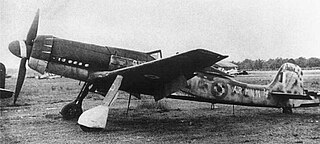 W
WThe Focke-Wulf Ta 152 was a World War II German high-altitude fighter-interceptor designed by Kurt Tank and produced by Focke-Wulf.
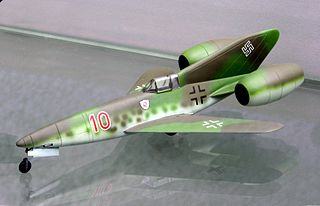 W
WThe Focke-Wulf Strahlrohrjager was a German swept wing, ramjet-powered interceptor aircraft proposal during World War II. The project was proposed at the same time as the Focke-Wulf Super Lorin and remained only a design study until the surrender of Nazi Germany.
 W
WThe Focke-Wulf Volksjäger, meaning "People's Fighter" in German, was a German emergency fighter project for the Luftwaffe. It was designed by Focke-Wulf industries towards the end of World War II as part of the defense effort against the devastating Allied bombing raids.
 W
WThe Heinkel He 100 was a German pre-World War II fighter aircraft design from Heinkel. Although it proved to be one of the fastest fighter aircraft in the world at the time of its development, the design was not ordered into series production. Approximately 19 prototypes and pre-production examples were built. None are known to have survived the war.
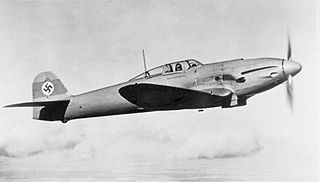 W
WThe Heinkel He 112 is a German fighter aircraft designed by Walter and Siegfried Günter. It was one of four aircraft designed to compete for the 1933 fighter contract of the Luftwaffe, in which it came second behind the Messerschmitt Bf 109. Small numbers were used for a short time by the Luftwaffe and some were built for other countries, around 100 being completed.
 W
WThe Heinkel He 113 was a fictitious German fighter aircraft of World War II, invented as a propaganda and possibly disinformation exercise.
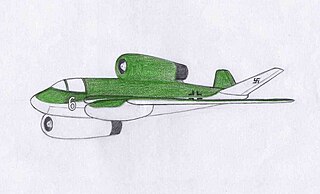 W
WThe Heinkel P.1073, known also as Strahljäger, was a fighter project developed for the Luftwaffe by Heinkel aircraft manufacturing company during the last years of World War II.
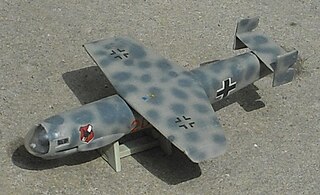 W
WThe Heinkel P.1077 was a single seat interceptor design developed for the Luftwaffe by Heinkel under the Emergency Fighter Program during the last year of the Third Reich. This rocket-powered project was originally known as He P.1068, but that name was later used for a Heinkel design project for a turbojet-powered medium bomber.
 W
WThe Heinkel P.1078 was a single seat interceptor developed for the Luftwaffe by Heinkel aircraft manufacturing company under the Emergency Fighter Program during the last years of the Third Reich.
 W
WThe Heinkel He P.1079 was a projected German V-tail all weather jet fighter designed by Heinkel Flugzeugwerke in the closing stages of World War II. The aircraft was only a design; it was not produced.
 W
WThe Junkers EF 126 was an experimental fighter proposed by the German Miniaturjägerprogramm of 1944–1945, for a cheap and simple fighter powered by a pulsejet engine. No examples were built during the war, but the Soviet Union completed both unpowered and powered prototypes.
 W
WThis is a list of variants of the Focke-Wulf Fw 190, with detailed descriptions.
 W
WThe Messerschmitt Bf 109 is a German World War II fighter aircraft that was, along with the Focke-Wulf Fw 190, the backbone of the Luftwaffe's fighter force. The Bf 109 first saw operational service in 1937 during the Spanish Civil War and was still in service at the dawn of the jet age at the end of World War II in 1945. It was one of the most advanced fighters when it first appeared, with an all-metal monocoque construction, a closed canopy, and retractable landing gear. It was powered by a liquid-cooled, inverted-V12 aero engine. It was called the Me 109 by Allied aircrew and some German aces, even though this was not the official German designation.
 W
WThe Messerschmitt Bf 110, often known unofficially as the Me 110, is a twin-engine Zerstörer and fighter-bomber developed in Nazi Germany in the 1930s and used by the Luftwaffe during World War II. Hermann Göring was a proponent of the Bf 110. Early variants were armed with two MG FF 20 mm cannon, four 7.92 mm MG 17 machine guns, and one 7.92 mm MG 15 machine gun for defence. Development work on an improved type to replace the Bf 110 - the Messerschmitt Me 210 - began before the war started, but its teething troubles resulted in the Bf 110 soldiering on until the end of the war in various roles, with its replacements: the Me 210 and the significantly improved Me 410 Hornisse.
 W
WThe Messerschmitt Bf 110, often (erroneously) called Me 110, was a twin-engine heavy fighter in the service of the Luftwaffe during World War II. Hermann Göring was a proponent of the Bf 110, and nicknamed it his Eisenseiten ("Ironsides"). Development work on an improved type to replace the Bf 110, the Messerschmitt Me 210 began before the war started, but its teething troubles resulted in the Bf 110 soldiering on until the end of the war in various roles, alongside its replacements, the Me 210 and the Me 410.
 W
WThe Messerschmitt Me 163 Komet is a German interceptor aircraft designed for point-defence that is the only rocket-powered fighter aircraft ever to have been operational and the first piloted aircraft of any type to exceed 1000 km/h (621 mph) in level flight. Designed by Alexander Lippisch, its performance and aspects of its design were unprecedented. German test pilot Heini Dittmar in early July 1944 reached 1,130 km/h (700 mph), an unofficial flight airspeed record unmatched by turbojet-powered aircraft for almost a decade.
 W
WThe Messerschmitt Me 210 was a German heavy fighter and ground-attack aircraft of World War II. Design started before the war, as a replacement for the Bf 110. The first examples were ready in 1939, but they proved to have unacceptably poor flight characteristics due to serious wing planform and fuselage design flaws. A large-scale operational testing program throughout 1941 and early 1942 did not cure the type's problems. The design entered limited service in 1942, but was soon replaced by the Messerschmitt Me 410 Hornisse, a further development of the Me 210. The failure of the Me 210's development program meant the Luftwaffe was forced to continue operating the Bf 110 after it had become outdated, despite mounting losses.
 W
WThe Messerschmitt Me 263 Scholle (plaice) was a rocket-powered fighter aircraft developed from the Me 163 Komet towards the end of World War II. Three prototypes were built but never flown under their own power as the rapidly deteriorating military situation in Germany prevented the completion of the test program.
 W
WThe Messerschmitt Me 309 was a prototype German fighter, designed in the early years of World War II to replace the Bf 109. Although it had many advanced features, the Me 309's performance left much to be desired and it had so many problems that the project was cancelled with only four prototypes built. The Me 309 was one of two failed Messerschmitt projects intended to replace the aging Bf 109, the other being the Me 209 of 1943.
 W
WThe Messerschmitt Me 410 Hornisse (Hornet) is a German heavy fighter and Schnellbomber used by the Luftwaffe during World War II. Though an incremental improvement of the Me 210, it had a new wing plan, longer fuselage and engines of greater power. The changes were significant enough for the aircraft to be renamed the Me 410.
 W
WThe Messerschmitt P.1110 was a design for a single-seat, high-altitude interceptor, prepared for the Luftwaffe by the Messerschmitt aircraft manufacturing company, under the Emergency Fighter Program during the last months of the Third Reich at the end of World War II.
 W
WThe Škoda-Kauba SK P14 was a ramjet-powered emergency fighter project for the Luftwaffe. It was designed by the Škoda-Kauba industries towards the end of World War II as part of the Third Reich defense effort against the devastating allied bombing raids.
 W
W W
W W
W